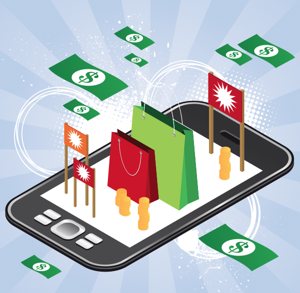
With consumers now increasing their usage of mobile phones for retail purposes, whether through browsing a web site, getting info for a product or making a purchase, retailers are tasked with making the experience as convenient as possible. Mobile devices accounted for 26% of Black Friday weekend sales, showing these merchants that the time to optimize this channel is now.
The RTP team discusses the potential impact mobile will continue to make throughout retail as the holiday season concludes, and 2016 gets underway. Additionally, the team highlights the steps retailers have to take to effectively adapt to the growing channel.
Debbie Hauss, Editor-In-Chief: I think the impact of mobile on the first round of the 2015 holiday season really took retailers by surprise. I don’t think most were expecting that type of mobile surge so soon. And because there’s been so much talk about the store remaining relevant – as statistics have shown that most shoppers still want to go to a physical store – retailers may not have been prepared for the mobile rush. So now many merchants may be taking another look at their inventory allocation to ensure that they’ll be able to meet the mobile demand; and they must consider what will happen with returns as a result. A lot of stores are still figuring out their employee allocation and organization around facilitating mobile returns and exchanges, so I would not be surprised if we see a lot of long lines, confused associates and frustrated shoppers during the post-New Year return rush.
Adam Blair, Executive Editor:
Any doubts that still lingered about mobile’s importance to digital commerce – and to retailing in general – had to be dispelled by data from this past Thanksgiving weekend. Mobile accounted for 26% of all online sales, and nearly half of Walmart’s orders came via mobile devices. Mobile has officially moved from research tool and influencer to transactional touch point. Retailers MUST make sure that it’s not just “possible” but actually “easy” for customers to buy via their mobile devices. Whether that entails sophisticated responsive design for mobile sites, rethinking mobile apps from the shopper’s point of view, or leveraging social networks’ growing list of “buy” buttons, retailers need to be ready for the even bigger mobile numbers that Black Friday 2016 will undoubtedly bring.
Alicia Fiorletta, Content Strategist: It’s exciting to see how mobile’s role in the shopper journey continues to grow and evolve. I remember when I first started at Retail TouchPoints and we were discussing the potential impact of SMS text-message marketing and how retailers can leverage that form of marketing to drive in-store traffic. We’ve clearly come a long way in five short years. With that said, through the end of the holiday season, I think we’ll continue to see consumers rely on their smartphones and tablets to shop at home. However, I think the real magic will happen when consumers use their smartphones to plan before the in-store shopping trip and to be more efficient while they’re in stores. Specifically, I think there’s some exciting opportunity for integrating location-based messaging with inventory availability, as well as synching wish lists across devices. That way, if you share something to your wish list while browsing on your desktop, you can access it while your in a store and on your mobile device.
Glenn Taylor, Associate Editor: Believe it or not, there are still many retailers that don’t offer high quality mobile apps to the consumer. In fact, compared to their peers, retailers as a whole aren’t doing so hot when it comes to the presentation, content and performance of their apps. So first and foremost, retailers must follow the lead of high performers such as Fanatics, Groupon and HauteLook to learn how to deliver the best mobile app experiences. I don’t want to completely rule out the buy buttons concept yet, but I feel that’s an alternative the major social networks and participating retailers are going to have to take more seriously if they want to personalize to the consumer habits.






